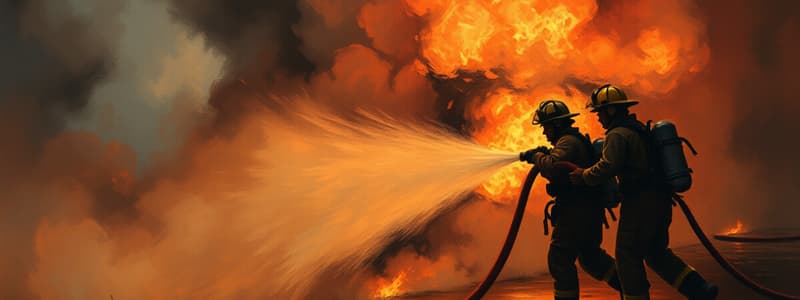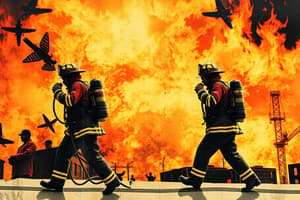Podcast
Questions and Answers
What is the primary objective when placing the first water stream during an offensive fire attack?
What is the primary objective when placing the first water stream during an offensive fire attack?
- To protect all exit routes for fire personnel
- To create a barrier against fire spread in all directions
- To achieve maximum water volume for extended periods
- To extinguish and/or cool the most endangered interior compartments (correct)
When are back up hose lines considered necessary during a fire operation?
When are back up hose lines considered necessary during a fire operation?
- To secure a safe egress route for personnel (correct)
- To initiate a secondary attack on the fire from a different angle
- When there is an imminent fire spread within the building
- When the fire has been completely controlled
What action should be taken if conditions deteriorate during a change from offensive to defensive operation?
What action should be taken if conditions deteriorate during a change from offensive to defensive operation?
- Pull hand lines out of the building if it is unsafe (correct)
- Request additional resources before exiting
- Continue fighting the fire until all hose is salvaged
- Immediately deploy multiple hose lines outside
Why should water streams be directed at exposures when immediate exposures are present?
Why should water streams be directed at exposures when immediate exposures are present?
What is the recommended water volume for back up hose lines in relation to primary lines?
What is the recommended water volume for back up hose lines in relation to primary lines?
What is the primary strategy for using fire attack hose lines in the offensive approach?
What is the primary strategy for using fire attack hose lines in the offensive approach?
Which of the following statements about back up hose lines is correct?
Which of the following statements about back up hose lines is correct?
When transitioning from offensive to defensive operations, what is the recommended action regarding hose lines?
When transitioning from offensive to defensive operations, what is the recommended action regarding hose lines?
What is the primary purpose of directing water streams at exposures as early as possible?
What is the primary purpose of directing water streams at exposures as early as possible?
What is the primary focus of the first water stream placed during an offensive fire operation when no victims are present?
What is the primary focus of the first water stream placed during an offensive fire operation when no victims are present?
Flashcards are hidden until you start studying
Study Notes
Basic Attack Hose Line Placement
- Effective offensive strategy requires hose lines with sufficient water volume for quick application to fires and hot surfaces.
- Hose lines must control access to critical pathways like hallways and stairways, essential for managing both fire and potential evacuations.
- Initial water stream should target the most threatened compartments first, choosing optimal positions for maximum impact on life safety and firefighter operations.
- If no victims are present, the priority should shift to fire suppression to prevent spread to nearby areas.
- When immediate exposures are at risk, direct water streams toward those areas early in the operation.
- Back up hose lines should be ready to secure escape routes, ensuring the safety of firefighters in potentially dangerous locations.
- Back up lines should ideally deliver equal or higher water volume to maintain efficacy.
- Transition from offensive to defensive operations should only happen when it's safe to retreat, avoiding risks for the sake of salvaging equipment.
- Quick egress is critical; do not hesitate to exit if conditions deteriorate dramatically, unless hose lines are vital for protecting crews during the escape.
Basic Attack Hose Line Placement
- Effective offensive strategy requires hose lines with sufficient water volume for quick application to fires and hot surfaces.
- Hose lines must control access to critical pathways like hallways and stairways, essential for managing both fire and potential evacuations.
- Initial water stream should target the most threatened compartments first, choosing optimal positions for maximum impact on life safety and firefighter operations.
- If no victims are present, the priority should shift to fire suppression to prevent spread to nearby areas.
- When immediate exposures are at risk, direct water streams toward those areas early in the operation.
- Back up hose lines should be ready to secure escape routes, ensuring the safety of firefighters in potentially dangerous locations.
- Back up lines should ideally deliver equal or higher water volume to maintain efficacy.
- Transition from offensive to defensive operations should only happen when it's safe to retreat, avoiding risks for the sake of salvaging equipment.
- Quick egress is critical; do not hesitate to exit if conditions deteriorate dramatically, unless hose lines are vital for protecting crews during the escape.
Studying That Suits You
Use AI to generate personalized quizzes and flashcards to suit your learning preferences.




